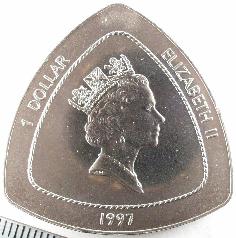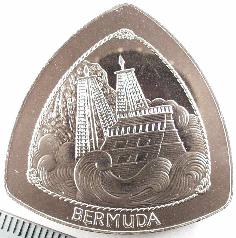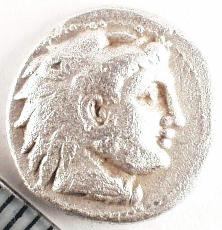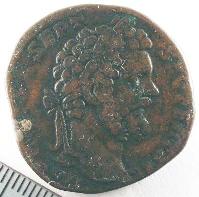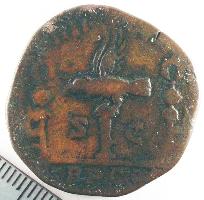Chatter
archive
also available
| Chicago Coin Club |
|---|
| Volume 49 No. 4 |
April 2003 |
|---|
Minutes of the 1010th Meeting
President Mark Wieclaw called the 1010th meeting of the Chicago Coin Club
to order on February 12, 2003 at 7:04PM.
The meeting was held at 1 Bank One Plaza.
The January minutes were approved.
Secretary/Treasurer Lyle Daly gave the Treasurer's report.
The club has $2537.73 in checking, $1043.72 in a Bank One account,
$1437.59 in a second Bank One account, and $1863.65 in a Dreyfuss account.
Speakers for the evening were Phil Carrigan and Carl Wolf.
The topic was building and maintaining a numismatic library.
The acquisition of diverse resources was discussed.
Carl showed a very useful storage box for periodicals and catalogs.
A handout with plans for the box was distributed.
There were eight participants in the evening's show and tell.
They presented as follows:
-
Don Dool - 3 coins bearing the date 1622
-
Bob Weinstein - several ancient counterfeits
-
Mark Wieclaw - uncut sheet of cloth notgeld
-
Sharon Blocker - bank premiums
-
Carl Wolf - Hmong ring money
-
Mike Metras - Books on Eithiopian coinage
-
Phil Carrigan - Canadian maritime province coins
-
Lyle Daley - copy of a Goetz medal for the Lusitania sinking and a Father Coughlin medal
Reading of Applications for Membership
There were no readings for membership.
Old Business
The giveaway for the CPMX was announced.
New Business
The replacements of Lyle Daley were announced.
The office has been divided between Steve Zitowsky who will serve as Treasurer
and Bob Weinstein who will serve as Secretary.
The meeting was recessed at 9:12 pm to be resumed at the 9th annual Chicago Paper Money Expo.
Respectfully submitted by Bob Weinstein
Minutes of the 1011th Meeting
President Mark Wieclaw called the 1011th meeting of the Chicago Coin Club
to order on March 12, 2003 at 7:12PM.
The meeting was held at 1 Bank One Plaza.
The February minutes were not delivered in time to appear in the March Chatter.
There was no Treasurer's report.
There was one guest present: Louis Jordan
First Vice-President Bob Feiler introduced the speaker for the evening, Louis Jordan.
The topic was The Role of Hogge Money in the Formation of the Sommer Islands Economy.
First Vice-President Bob Feiler thanked Louis for his lecture
and presented him with the CCC speakers medal and an ANA educational award.
There were eight participants in the evening's show and tell. They presented as follows:
-
Sharon Blocker - Bermuda coins and banknotes and a $5 gold won at a raffle
-
Bob Leonard - hogge money
-
Carl Wolf - Flower Tok from Burma
-
Mike Metras - Hillside Coin Club 250th Meeting souvenior
-
Mark Wieclaw - Hemi-drachm of Alexander the Great, sestertius of Septimus Severus, uncut sheet of cloth notgeld, and a cloth notgeld note with embroidered design
-
Bob Feiler - Broken banknotes
-
Louis Jordan - Maryland 6 pence
-
Jeff Rosinia - water meter tokens
Reading of Applications for Membership
There were 3 readings for membership:
second readings for Donald Wilkensen of Ft. Wayne, IN, and Dan Freeland of MI;
a first reading for Louis Jordan of South Bend, IN.
Old Business
Carl Wolf showed the giveaway for the CPMX.
The CICF giveaway will be Salt and Pepper Money
with the article being written by Bob Leonard.
Carl Wolf encouraged more members to write numismatic articles.
He showed some of the many pieces by club members that have been published in the past.
Carl would like members to contact him about projects you are working on or thinking of doing.
New Business
Mark Wieclaw advised that next year is the Club's 85th anniversary
and that perhaps we should do something for the event.
Bob Feiler suggested a commemorative medal.
Mark Wieclaw suggested an early start on the annual banquet.
Bob Feiler volunteered for the committee.
Carl Wolf announced that member John Wilson is running for ANA governor and is seeking the club's endorsement.
A motion to endorse John Wilson for ANA governor was passed.
The meeting was adjourned at 9:10 pm..
Respectfully submitted by Bob Weinstein
Speaker's Wor[l]d
Role of Hogge Money in the Formation of the Sommer Islands Economy
Presented by
Louis Jordan,
of the Department of Special Collections
at Notre Dame University, to our March 12, 2003 meeting.
Little first hand information about Hogge money is available,
but after providing an overview of the early European experience in Bermuda,
Louis examined island life in an effort to explain the short
lifetime of Hogge money in Bermuda commerce.
This talk is a condensation of a paper for publication.
In 1505, a party led by Juan de Bermudez were the first Europeans
in what is now known as Bermuda.
In 1515, Captain Gonzalo de Oviedo left hogs on the islands,
anticipating the hogs would multiply and provide
food for future European visitors.
In 1607 the Virginia Plantation first settled Jamestown,
but the death of most of the first settlers meant the company
had to send relief if the settlement were to survive.
In 1609 George Sommer on the Sea Adventurer led a nine-ship relief fleet.
Damaged and separated from the fleet, they landed in Bermuda.
The crew hunted the numerous wild hogs while two new boats were built.
Two crew were left on the on the island when the two boats left for Jamestown.
Too ill for the return crossing, Somers and another man were left with the first two.
Somers died there in 1610,
but the islands' prospects were attractive enough to have
Richard Moore commissioned as the first governor in 1612.
A subsidiary company of the Virginia Plantation planned a plantation for the islands,
and the June 21, 1615 royal charter incorporating the Somer Islands Company
permitted coinage.
Although food was available locally from farming corn, fishing, and hunting,
liquor, metal tools, and other manufactured goods were imported.
The London investors had expected profits from pearls, silk, gold,
and other items to rival those from the Spanish colonies.
Those profits were not forthcoming, so the ongoing expenses came from investors,
not out of their profits from the company.
Therefore the company sent only the minimal supplies.
Before the land was surveyed,
most people did not build a house on what might be their land;
the result was virtually all the inhabitants were employed
by the company on public works.
A reasonable day's wage was 20 pence for a workman
and 12 pence for a laborer.
The company store was the only source of supplies,
and since no coins were available the economy operated on the books.
Later, instead of paying wages, money from profits derived by selling goods
in London went to investors while colonists received credit at the store.
But some colonists were not happy with the long time until renumeration was received.
For those who did not want that,
the company issued base coinage good at the company store;
it also passed locally.
We do not know where the coins were made, or by whom.
Journal entries of Governor Nathaniel Butler (third governor,
arrived October 20, 1619) provide our first mention of base coinage;
he also described food, clothes, and other aspects of the local condition.
There is no other primary written evidence of their use or circulation.
With no solid references, Louis is left to conjecture;
that the the coins arrived in the last half of 1616,
either with or after second governor Daniel Tucker's
arrival on May 16, 1616.
This Hogge money features a hog on one side and a ship on the other.
They were made of copper, with a thin wash of silver.
Even though individual pieces still are found (and some are
in terrible shape), not many more than 50 pieces are known;
that agrees with Louis' belief the original mintage was small.
He also noted that there are about twice as many obverse dies
than reverse dies known.
| Denomination |
Obv |
Rev |
|---|
| shilling |
2 |
1 |
| 6 pence |
4 |
2 |
| 3 pence |
1 |
1 |
| 2 pence |
2 |
1 |
The major agricultural product became tobacco, with two harvests annually.
The first crop (in December, 1616) brought 2sh 6p per pound in London,
but the farmers had hoped for 5 shillings.
With half the profits to the shareholders and half to the tenant farmers,
this success signaled the decline of the company store's importance,
and it closed in 1619.
Instead of doing business with tokens or on the book,
the new medium of exchange was tobacco (on credit during the year,
with settlement at harvest).
In 1620, public works were paid for with tobacco,
and taxes were paid in tobacco.
Although a token economy might have worked better internally,
pirates would not accept tokens for their smuggled goods, only tobacco.
In time, over production of tobacco created its own problems;
the 1629 London price of 1sh per pound meant an on-farm price
of 1-3p per pound.
But that sounds like a topic for another meeting.
Show and Tell
Each image has a scale in the lower-left corner,
with the tics spaced 1 mm apart.
Because the brightness and contrast were manipulated on a computer,
the coloring of a coin's image differs from the coin's actual coloring.
-
To complement the topic of the evening's featured speaker,
Sharon Blocker
showed recent issues from Bermuda,
starting with the $5 piece produced by the Singapore mint.
It features the early ship Sea Adventurer,
and the .991 fine coin weighs five ounces.
A 1992 $5 coin honored the Olympics in both Albertville and Barcelona.
A number of $1 coins featuring animals were shown,
and Sharon ended the coins with a triangular coin featuring an early ship.
An older $10 note featuring a harbor scene and birds
was followed by newer $2, $5, and $10 notes from the Bermuda Monetary Authority.
-
Bob Leonard
also carried the featured speaker's topic into his exhibit,
starting with a 12 pence shilling example of Hogge money;
parts of the design were discernable on the projected image.
Then he showed the excellent book by the Bermuda Monetary Authority on Bermuda money;
the book lists individual specimens of the early pieces,
and claims the Loye Lauder specimen (Bob's coin) is a Red Book plated coin.
The Red Books Bob brought had different pieces plated.
Finally Bob showed the the Auction catalog of Lauder's 2, 3, 6, and 12 pence pieces;
all were great pieces except for the 12 pence which was not pictured.
Bob feels that the blunt description and lack of a picture allowed him to win the coin at auction.
In conclusion, Bob thinks more than 50 are known, but still less than 100 known.
-
Carl Wolf
showed a framed piece of Willow (Flower) money from S.E. Asia,
characterized by a "frost on glass" crystalization.
His piece from the 1700s weighs 150 grams and is 85% pure silver.
The earliest known pieces of this style dates to the 1200s.
This was not the only silver ingot currency at that time,
but all have a reverse concave pit, possibly to make it resemble a sea shell.
-
Mike Metras
started by showing two Illinois state quarters in a case,
made by the Hillside Coin Club as a keepsake of their 250th meeting.
Then Mike related how preparing a talk on trains on paper money
led him to develop an easy way to organize pictures of notes.
Using html, he described it as a lazy person's way of avoiding a data base.
-
Mark Wieclaw
showed ancients and notgeld:
-
A hemidrachm of Alexander the Great, featuring the same design as
on the drachm and tetradrachm but much rarer.
The obverse shows a head of a young Herakles in lion skin;
the reverse shows a seated Zeus, anchor in field, monogram beneath throne.
-
A legionary sestertius of Septimus Severus, issued for the first legion to proclaim him emperor.
Although 14 legions issued denarii, this is the only legionary sestertius.
The legend is "LEG XIIII GEMMV",
and the reverse features a legionary eagle between two standards.
-
Various examples of a 100 Mark uniface Notgeld note from Bielefeld:
a single,
a sheet of ten, with 6 horizontal and four vertical,
and another single but with scalloped edges and an embroidered back.
-
Bob Feiler
recently
found an envelope of odd denomination notes he had not seen for a while.
Nautical scenes, such as shipbuilding, ships, and boats predominated,
even a City of Omaha note had ships in a seascape.
-
Louis Jordan
first showed his book on John Hull;
his previous talk to the club was the first chapter of that book.
Then he showed a Maryland Lord Baltimore 6 pence dated 1659.
Twenty pieces had been found in an estate and auctioned last November;
Notre Dame bought one of them.
-
Jeff Rosinia
recently bought a ringbinder of miscellaneous items.
He showed us a range of water meter medallions;
each had a series of holes, and by each hole was the the number of gallons
wasted per day at a set pressure.
He concluded with some key chain fobs with license plate numbers
distributed by Disabled American Veterans.
Minutes of the March 26th Board Meeting
The Board of Directors of the Chicago Coin Club met at 6:00pm Wednesday March 26th, 2003.
The first issue discussed was how to increase overall membership in the club.
It was agreed that the club needs to do more self promotion.
Announcing our upcoming programs in numismatic publications
was an area which was felt to be worth exploring.
Jeff Rosinia volunteered to work on an ad we could run on a regular basis.
Involvement in some way with the Mid-America show was also discussed.
Bob Weinstein reminded the board that we had done an educational presentation
in the past when the show was still in Milwaukee.
Carl Wolf said he did not think they had an educational program
for that show anymore but that it would be worth seeing
if they would be interested in having us run some sort of presentation.
Another suggestion was to do talks at public libraries.
Mark Wieclaw was dubious of the value of this towards our goal.
Mark has given talks at libraries and the turnout was not great
and many of the attendees were more interested in asking
the value of coins they had come across than they were in the topic presented.
The next topic was active membership.
The club has over one hundred members but only about 20-25 attend meetings regularly.
One reason is that many members do not live in the Chicago area.
It was felt that a larger reason was the perception of the club as too high brow.
Some apparently feel we are oriented more toward the study
of the rare and unusual and have no interest in anything else.
It was agreed that we need to promote ourselves to a somewhat wider audience of collectors.
A large proportion of the exhibits tend to be world coinage and ancients.
US collectors might easily get the feeling that the club is not for them.
Carl Wolf suggested that most of those who usually exhibit ancient or foreign coins
started with US coins and might occasionally exhibit pieces from their US collections.
Carl Wolf asked for suggestions or volunteers to fill out the remainder of the year's meetings.
Several of those present volunteered to be future speakers.
The 85th anniversary next year was discussed next.
It was asked whether this was an anniversary that we really needed to celebrate.
Some felt that having a large event every five years was too much.
It was agreed that a medal would be issued to mark the event.
Business moved on to the subject of an ANA convention for Chicago.
The last show was in 1999.
We have been pressing for 2019 for the 100th anniversary of the club.
We do not want to have 20 years between shows.
Unfortunately there are shows scheduled for Milwaukee in 2007 and St. Louis in 2008.
The close proximity of these cities to Chicago makes getting a show here in 2009 or 2010 less likely.
It is also possible that these slots will be given to west coast cities
because there have been few annual shows there compared to other regions.
It was suggested that Mark Wieclaw contact Brenda Bishop,
the Convention Coordinator of the ANA, as soon as possible to discuss our options.
Carl Wolf spoke on the subject of the ANA fundraiser which was intended for the CICF.
This event has been postponed for now.
By unfortunate accident copy #1 of the giveaway for the CPMX was given away.
Normally this would go into the club archives.
It was decided that a random number from the remaining stock shall be given to the archives in its place.
It was noted that the club needs new business cards
and new guest cards reflecting changes of club information.
The meeting ended at 8:10pm
Respectfully submitted by Bob Weinstein
Our 1012th Meeting
| Date: | April 9, 2003 First session |
| Time: | 7:00 PM |
| Location: | Downtown Chicago.
Please remember the security measures at our meeting building:
give a club officer the names of all your guests prior to the meeting day;
and everyone must show their photo-ID at the security desk. |
| Featured speaker: | John Wright
- 300 Years of Portraits of the Caesars as Shown on Sestertii Coinage |
|
John Wright is known for his collection and knowledge
of U.S. Large Cents.
But many don’t know that for over twenty years
he has been collecting and studying Roman bronze coinage.
Join him as he shows portraits of the Caesars
as reflected on sestertii coins from Julius Caesar (44 BC)
through Postumus (268 AD).
The talk will include the history of how each came to the throne,
what they did for/to the empire, and how each met his end.
|
| |
| Date: | April 26, 2003 Second session |
| Time: | 1:00 PM |
| Location: | at the Chicago International Coin Fair (CICF),
which is held at the Holiday Inn O'Hare, 5440 North River Road, Rosemont, IL.
No admission charge for our meeting. |
| Featured speaker: | J. Graham Esler, Retired Chief Curator, Bank of Canada's Currency Museum
- The Canadian Silver Nuisance, 1865-1870 |
|
By 1865 in Canada, U.S. silver coins traded everywhere at face value,
except at banks and government offices. This is the story of
how unscrupulous traders shipped large quantities of silver coins into
Canada, traded them at full value, only to buy the coins back later from a
government agency at a discount! Canadian citizens were paid in U.S. silver
coins, only to have their bank deduct a percentage when it was deposited.
Join Mr. Esler as he relates the details of this little known story, the
hardships it caused the average Canadian and how the circumstances lead
to the creation of Canadian's first national currency.
|
Important Dates
|
Our April meeting will consist of two sessions:
we will end the first session with a recess (instead of an adjournment),
and we will reconvene for the second session at the CICF. |
| April |
9 |
CCC Meeting - Featured Speaker - John Wright on 300 Years of Portraits of the Caesars as Shown on Sestertii Coinage |
| April |
25-27 |
28th Annual Chicago International Coin Fair (CICF)
at the Holiday Inn O'Hare, 5440 North River Road, Rosemont.
Admission is $5. |
| |
| April |
26 |
Ancient Coin Club of Chicago Meeting - 11am at the Chicago International Coin Fair (CICF),
which is held at the Holiday Inn O'Hare, 5440 North River Road, Rosemont, IL.
No admission charge for the meeting.
Featured Speaker - David Michaels on
Roman Military Equipment as Pictured on Coinage |
| |
| April |
26 |
CCC Meeting - 1pm at the Chicago International Coin Fair (CICF),
which is held at the Holiday Inn O'Hare, 5440 North River Road, Rosemont, IL.
No admission charge for our meeting.
Featured Speaker - J. Graham Esler, Retired Chief Curator, Bank of Canada's Currency Museum on
The Canadian Silver Nuisance, 1865-1870 |
| |
| April |
26 |
International Primitive Money Society Meeting - 4pm at the Chicago International Coin Fair (CICF),
which is held at the Holiday Inn O'Hare, 5440 North River Road, Rosemont, IL.
No admission charge for the meeting.
Featured Speaker - Bruce W. Smith on
Money Types of the Ancient Chinese City of Lin
Lin was a city in China’s Shansi Province abandoned over 2000 years ago. Its
ruins are located in a remote mountainous region near the Yellow River and
the border of Inner Mongolia. Although cities in ancient China usually issued only
one kind of currency, Lin is the only city in China to issue knife currency,
three kinds of spade currency and round currency. Little is known about
Lin, aside from a few references in historical works and the currency they
left behind. A student of Chinese coinage for over thirty years, Mr. Smith
will tell the story of Lin as seen through its primitive currency and offer
an explanation as to the reason this remote place issued so many currencies.
|
| |
| May |
14 |
CCC Meeting - Featured Speaker -to be announced |
| |
| June |
11 |
CCC Meeting - Featured Speaker - Steve Feller on Newly Discovered Facts about Confederate Coinage |
Birthday and Year Joined
| May |
2 |
Donn Pearlmann |
1979 |
| May |
3 |
Roy R. Grundy |
1981 |
| May |
5 |
Dennis Fuller |
1997 |
| May |
8 |
Sharon Blocker |
2000 |
| May |
10 |
Marty Vink |
1952 |
| May |
11 |
William A. Burd |
1993 |
| May |
11 |
Jeffrey Rosinia |
1995 |
| May |
15 |
Jay M. Galst |
1991 |
| May |
17 |
Shirley Valenziano |
1984 |
| May |
17 |
Paul R. Hybert |
1994 |
| May |
23 |
Robert J. Weinstein |
1991 |
Chatter Matter
All correspondence pertaining to Club matters
should be addressed to the Secretary and mailed to:
CHICAGO COIN CLUB
P.O. Box 2301
CHICAGO, IL 60690
Visit Our Web Site
http://www.ChicagoCoinClub.org/
Contacting Your Editor
| Paul R. Hybert
|
| prhybert@worldnet.att.net |
Club Officers
| Mark Wieclaw | - President |
| Robert Feiler | - First Vice President |
| Jeff Rosinia | - Second Vice President |
| |
| Directors: | Lyle Daly
Mike Metras
Steve Zitowsky
Carl Wolf |
| |
| Other positions held are: |
| Robert Weinstein | - Secretary |
| Steve Zitowsky | - Treasurer |
| Paul Hybert | - Chatter Editor |
| Phil Carrigan | - Archivist |
